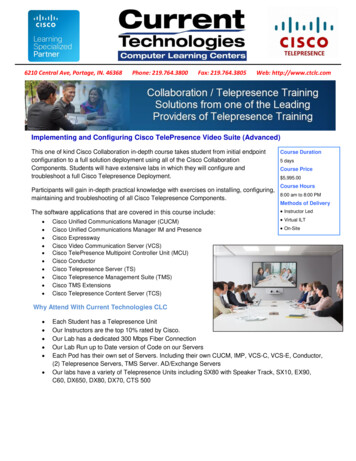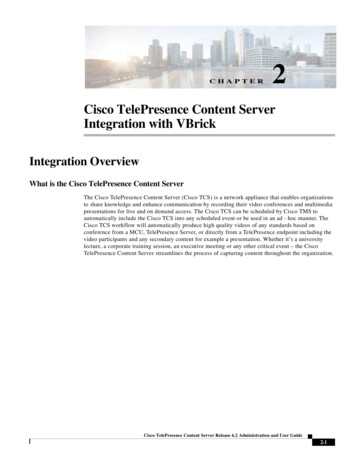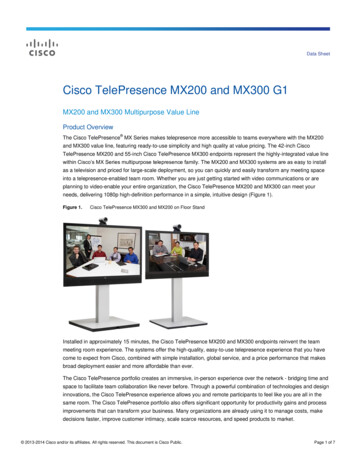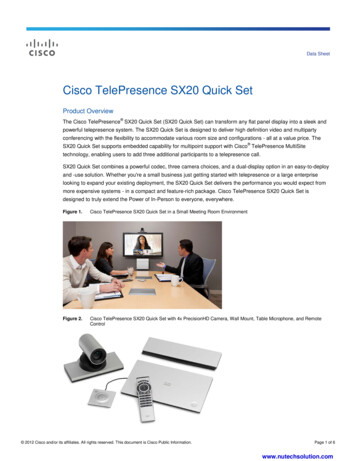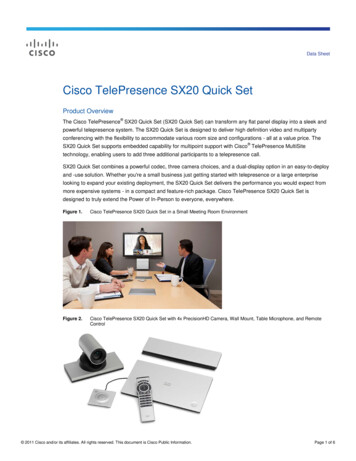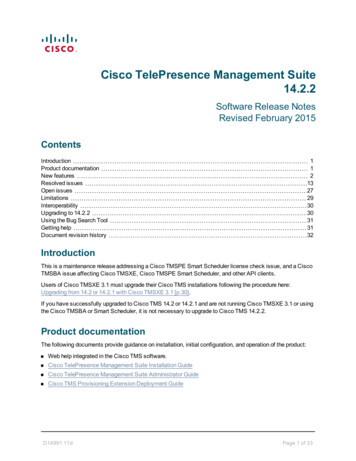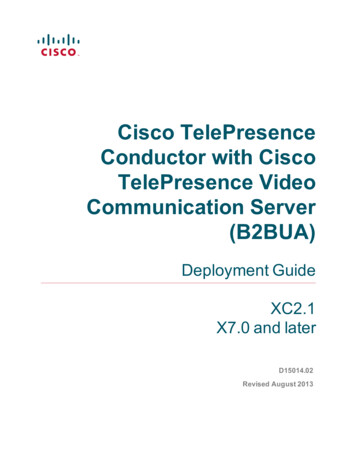
Transcription
Cisco TelePresence Video CommunicationServerX8.9Release NotesFirst Published: December 2016Last Updated: February 2017ContentsPrefaceChange HistorySupported PlatformsProduct DocumentationNew Features in X8.9Edge Traversal Integration with Cisco Meeting Server(Preview) IM and Presence Service Federation With Skype for Business or Office 365OrganizationsREST API ExpansionAllow Jabber on iOS to Use Safari for SSO Over MRA(Preview) Shared Line / Multiple Line Support for MRA Endpoints(Preview) Smart Call HomeSecure Install WizardImproved DiffServ Code Point MarkingImproved Maintenance ModeOther Changes and EnhancementsOpen and Resolved IssuesNotable Issues in this VersionLimitationsUnsupported Features (General)Unsupported Cisco Meeting Server Web ProxyUnsupported Endpoint Features When Using MRAUnsupported Cisco VCS Features and Limitations When Using MRAUnsupported Contact Center Features When Using MRAInteroperabilityNotable Interoperability ConcernsCisco Systems, Inc.1www.cisco.com222344555666778899991010111111
Cisco TelePresence Video Communication Server Release NotesPrefaceUpgrading to X8.9Prerequisites and Software DependenciesUpgrade InstructionsUsing Collaboration Solutions AnalyzerUsing the Bug Search ToolObtaining Documentation and Submitting a Service RequestCisco Legal InformationCisco Trademark1111131414151717PrefaceChange HistoryTable 1 Release Notes Change HistoryDateChangeReasonFebruary 2017Republished with clarification for scope of shared line/ multiple linefeature.Customer foundissue.December2016First publication.X8.9Supported PlatformsTable 2 Cisco VCS Software Versions Supported by PlatformPlatform nameSerial NumbersScope of software version supportSmall VM (OVA)(Auto-generated)X8.1 onwardsMedium VM (OVA)(Auto-generated)X8.1 onwardsLarge VM (OVA)(Auto-generated)X8.1 onwardsCE500* (Cisco VCS pre-installed onUCS C220 M3L)52C#####X8.1.1 onwardsCE1000* (Cisco VCS pre-installed onUCS C220 M3L)52B#####X8.1.1 onwardsCE1100 (Cisco VCS pre-installed onUCS C220 M4L)52D#####X8.6.1 onwards* As of 26th February 2016, you cannot order the CE500 and CE1000 appliances from Cisco. See the End-of-saleannouncement for other important dates in the lifecycle of these platforms.Some VCS hardware appliances are not supportedWe do not support this Cisco VCS software version on the 1st generation Cisco VCS hardware appliances, serialnumbers 52A######.2
Cisco TelePresence Video Communication Server Release NotesProduct DocumentationThe following documents provide guidance on installation, initial configuration, and operation of the product:For installing the Cisco VCS, see: Cisco VCS Virtual Machine Installation Guide on the VCS installation guides page. Cisco Video Communication Server CE1100 Appliance Installation Guide on the VCS installation guides page.For general administration topics, reference, and maintenance, see: Cisco TelePresence VCS Administrator Guide on the Cisco TelePresence VCS maintain and operate guidespage. Cisco TelePresence VCS Serviceability Guide on the Cisco TelePresence VCS maintain and operate guidespage.Other documents that may be relevant in your environment: Registrar:See Cisco Single VCS Control - Basic Configuration Deployment Guide on the VCS configuration guidespage. Firewall Traversal:See Cisco TelePresence VCS Basic Configuration (Control with Expressway) Deployment Guide on the VCSconfiguration guides page. Cisco Spark: Hybrid services knowledge base Clustering:See the Cisco VCS Cluster Creation and Maintenance Deployment Guide, for your version, on the CiscoTelePresence Video Communication Server (VCS) configuration guides page. Certificates:See Cisco VCS Certificate Creation and Use Deployment Guide on the VCS configuration guides page. Unified Communications:See Mobile and Remote Access Through Cisco Video Communication Server on the VCS configuration guidespage. Cisco Meeting Server:See Cisco VCS with Cisco Meeting Server Deployment Guide on the VCS configuration guides page.Cisco Meeting Server configuration guides pageSee Cisco Meeting Server API Reference Guide on the Cisco Meeting Server programming guides page. Microsoft Infrastructure:See Cisco VCS and Microsoft Infrastructure Deployment Guide on the VCS configuration guides page.3
Cisco TelePresence Video Communication Server Release NotesNew Features in X8.9New Features in X8.9Table 3 Feature History by Release NumberFeature / changeX8.9Edge Traversal of Microsoft SIP Traffic for Cisco Meeting ServerSupportedMeeting Server Web ProxyNOT SUPPORTEDIM and Presence Service Federation With Skype for Business or Office 365 OrganizationsPreviewREST API ExpansionSupportedAllow Jabber for iPhone and iPad to Use Safari for SSO Over MRASupportedShared Line / Multiple Line Support for MRA EndpointsPreviewSmart Call HomePreviewSecure Install WizardSupportedDiffServ Code Point MarkingSupportedMaintenance Mode For MRASupportedX8.9 Changes and EnhancementsSupportedEdge Traversal Integration with Cisco Meeting ServerThe Cisco VCS pair at the edge of the network can now traverse Microsoft SIP traffic to and from Cisco MeetingServer spaces. This enables collaboration in spaces between your users and people from external organizations thatuse Office 365 or Microsoft Skype for Business infrastructure.Two Cisco VCS enhancements help you configure these collaboration scenarios: The DNS zone can do SRV lookups for the Microsoft federation service (. sipfederationtls.tcp.example.com.) Search rules now have the ability to route calls based on which variant of SIP is used on the callSee Cisco VCS with Cisco Meeting Server Deployment Guide on the VCS configuration guides page.4
Cisco TelePresence Video Communication Server Release NotesNew Features in X8.9(Preview) IM and Presence Service Federation With Skype for Business or Office365 OrganizationsThe Cisco VCS pair at the edge of the network can now traverse messaging and presence traffic between IM andPresence Service and external organizations using Skype for Business or Office 365.This feature is in preview as it requires corresponding changes to Cisco Unified Communications Manager IM andPresence Service that are not yet released.See Cisco VCS with Cisco Meeting Server Deployment Guide on the VCS configuration guides page.REST API ExpansionIn X8.8, we introduced a new API to simplify remote configuration. Third party systems, such as Cisco PrimeCollaboration Provisioning, can now use the API to configure the following features / services on the Cisco VCS: Mobile and Remote Access (MRA) Business to business (B2B) callsThe API is self-documented using REST API Markup Language (RAML).See Cisco Video Communication Server REST API Reference Guide on the VCS configuration guides page.Allow Jabber on iOS to Use Safari for SSO Over MRAThis option applies if you use single sign-on (SSO) and have Cisco Jabber iOS endpoints that access UnifiedCommunications services from outside the network. In this case, by default the identity provider's authenticationpage is displayed in an embedded web browser (not the Safari browser) on the iOS devices. That default browser isunable to access the iOS trust store, and so cannot use any certificates deployed to the devices. From X8.9, you canoptionally configure Cisco VCS Expressway to allow Jabber on iOS devices to use the native Safari browser. Becausethe Safari browser is able to access the device trust store, you can now enable password-less authentication or twofactor authentication in your SSO deployment.CaveatA potential security issue exists for this option. The mechanism to return browser control from Safari to Jabber afterthe identity provider authentication completes, uses a custom URL scheme that invokes a custom protocol handler.It's possible that another application other than Jabber could intercept the scheme and gain control from iOS. In thatcase, the application would have access to the OAuth token in the URL.If you are confident that your iOS devices will not have other applications that register the Jabber custom URLscheme, for example because all mobile devices are managed, then it's safe to enable the option. If you areconcerned about the possibility of another app intercepting the custom Jabber URL, then do not enable theembedded Safari browser.Note: Make sure that you apply this option consistently in Cisco VCS Expressway and in Unified CM. If you decide toenable or disable it in one application, do the same in the other. The relevant settings are: Allow Jabber iOS clients to use embedded Safari browser in Cisco VCS Expressway(Configuration Unified Communications Configuration Single Signon section) SSO Login Behavior for iOS in Unified CM(System Enterprise Parameters SSO Configuration section)Supported endpoints Cisco Jabber for iOS 11.8 or later, on devices using iOS 9 or laterSupported Unified Communications services5
Cisco TelePresence Video Communication Server Release NotesNew Features in X8.9 Cisco Unified Communications Manager 11.5(1)SU1 or later Cisco Unity Connection 11.5(1) or later(Preview) Shared Line / Multiple Line Support for MRA EndpointsCisco VCS now supports pass through of Unified CM shared line and multiple line features for endpoints that areconnecting by Mobile and Remote Access.The benefit of this feature is that remote and mobile endpoint users can use features, like barge, conference barge,hold on one device and resume on another, in the same way as they would when they are on the premises.You need to configure multiple and shared lines for users and their MRA devices on Unified CM.Required versions: Unified CM 11.5(1)SU2 or later Cisco VCS X8.9 or later Cisco IP Phone 7800 Series and Cisco IP Phone 8800 Series phones, with firmware version 11.5(1) or laterNote: This feature is disabled by default, because it impacts some features on earlier versions of Unified CM.If you are using a Unified CM version before 11.5(1)SU2, and you enable SIP Path headers on Cisco VCS Control, thefollowing Unified CM features will report the MRA devices' IP addresses instead of the Cisco VCS's IP address: Device Mobility Real-Time Monitoring Tool (RTMT) Cisco Emergency Responder (CER)Other features may also be affected by this change. The devices' IP addresses are not useful for determining theirlocation, as they are typically from reserved private ranges and could overlap with your organization's internal range.(Preview) Smart Call HomeSmart Call Home is a free embedded support capability for Cisco VCS. It offers proactive diagnostics and real-timealerts, enabling higher network availability and increased operational efficiency.Smart Call Home notifies users of Schedule- and Event-based notifications. Schedule-based: inventory, telemetry and configuration messages used to generate a Device Report andimprove hardware and software quality by identifying failure trends. You can find these notifications posted onthe first day of every month. Event-based: asynchronous events already supported by Cisco VCS such as alarms and ACRs. You will findthese notifications posted to the Smart Call Home server as and when they occur.You can opt to keep your organization's details anonymous. In this case Cisco VCS sends reports to the Smart CallHome server as normal, but the server does not send out notifications.Secure Install WizardThe Cisco VCS now includes an Install Wizard that helps make the deployment and configuration of your systemeasier and more secure.The Install Wizard guides you through the initial configuration required to get your system up and running securely.Any further configuration is then possible using the web interface or CLI.Only the person authorized to complete the system installation can access and complete the initial setup on thesystem console (or VM equivalent). All accounts on the Cisco VCS are disabled upon first boot until the installation is6
Cisco TelePresence Video Communication Server Release NotesNew Features in X8.9complete. The system is also not accessible over the network interface until the installation has been completed andsecured.In a VM deployment, any preconfigured data gets imported when the VM boots for the first time and you are notrequired to re-enter data.The Install Wizard does not affect the upgrade procedure for an existing system, as the system maintains any datathat you have already configured.Improved DiffServ Code Point MarkingIf you use our Unified Communications Mobile and Remote Access solution, from X8.9 the Cisco VCS supportsimproved DSCP (Differentiated Service Code Point) packet marking for traffic passing through the firewall. DSCP is ameasure of the Quality of Service level of the packet. To provide more granular control of traffic prioritization, DSCPvalues are set (marked) for these individual traffic types:Traffic typeSupplied default valueWeb UI fieldVideo34QoS VideoAudio46QoS AudioXMPP24QoS XMPPSignaling24QoS SignalingBefore X8.9 you had to apply DSCP values to all signaling and media traffic collectively.You can optionally change the default DSCP values from the System Quality of Service web UI page (or the CLI).Notes: DSCP value "0" specifies standard best-effort service. DSCP marking is applied to SIP and H.323 traffic. DSCP marking is applied to TURN media, providing the TURN traffic is actually handled by the Cisco VCS.Existing QoS/DSCP Commands and API are DiscontinuedFrom X8.9 we no longer support the previous methods to specify QoS/DSCP values. The former Web UI settingsQoS Mode and QoS Value, CLI commands xConfiguration IP QoS Mode and xConfiguration IP QoS Value andcorresponding API are now discontinued. Do not use these commands.What if I currently use these commands?When you upgrade the Cisco VCS, any existing QoS value you have defined is automatically applied to the new fieldsand replaces the supplied defaults. For example, if you had a value of 20 defined, all four DSCP settings (QoS Audio,QoS Video, QoS XMPP, QoS Signaling) are set to 20 also.We don't support downgrades. If you need to revert to your pre-upgrade software version, the QoS settings are resetto their original supplied defaults. So QoS Mode is set to None and QoS Value is set to 0. You will need to manuallyredefine the values you want to use.Improved Maintenance ModeMaintenance mode on the Cisco VCS has been enhanced so that you can bring an MRA system down in a managedway.When you engage maintenance mode, the Cisco VCS stops accepting new calls or proxy (MRA) traffic. Existing callsand chat sessions are not affected.As users end their sessions normally, the system comes to a point when it is not processing any traffic of a certaintype, and then it shuts that service down.7
Cisco TelePresence Video Communication Server Release NotesOpen and Resolved IssuesIf users try to make new calls or start new chat sessions while the Cisco VCS is in maintenance mode, the clients willreceive a service unavailable response, and they might then choose to use another peer (if they are capable). Thisfail-over behavior depends on the client, but restarting the client should resolve any connection issues if there areactive peers in the cluster.The Unified Communications status pages also show (Maintenance Mode) in any places where MRA services areaffected.Other Changes and Enhancements You can nominate an administrator account as an emergency account. In case the Cisco VCS disallows localauthentication but is unable to connect to a remote authentication service. We have removed the limitation that TURN services should not be enabled on a system that is being used forMRA. We did this to allow services that require TURN to coexist with MRA. One example is edge traversal forCisco Meeting Server.Note: This change does not make Jabber Guest compatible with MRA. It also does not mean that TURN can beused for MRA. The change simply means that MRA is not impacted if you enable TURN services (for otherreasons). We have discontinued the pre-X8.9 API and CLI commands for defining QoS/DSCP values: xConfiguration IPQoS Mode and xConfiguration IP QoS Value. They are replaced by new commands / web UI settings. The web administration port is now configurable, on the System Administration page. The default port isstill 443. From X8.9 onwards, automated intrusion protection is enabled, by default, for the following is change affects new systems. Upgraded systems keep their existing protection configuration.Open and Resolved IssuesFollow the links below to read the most recent information about the open and resolved issues in this release. All open issues, sorted by date modified (recent first) Issues resolved by X8.98
Cisco TelePresence Video Communication Server Release NotesLimitationsNotable Issues in this VersionLimitationsUnsupported Features (General) DTLS is not supported through the Cisco VCS Control/Cisco VCS Expressway. SRTP is used to secure callsinstead; attempts to make DTLS calls will fail. SIP UPDATE method. Features that rely on the SIP UPDATE method (RFC 3311) will not work as expectedbecause the Cisco VCS does not support this method. Audio calls may be licensed as video calls in some circumstances. Calls that are strictly audio-ONLY consumefewer licenses than video calls. However, when audio calls include non-audio channels, such as the iXchannel that enables ActiveControl, they are treated as video calls for licensing purposes.Unsupported Cisco Meeting Server Web ProxyCAUTION: Do not use the Meeting Server Web Proxy feature. This feature is not supported with this release ofCisco VCS, due to known issues.We've added a reverse https proxy for Meeting Server, which enables off-premises users to browse to a MeetingServer Web Bridge. Users can manage or join spaces without having any software other than a supported browser.9
Cisco TelePresence Video Communication Server Release NotesLimitationsThe proxy requires very little additional configuration on the Cisco VCS pair; you simply enter the Meeting Serverlistening address on the Cisco VCS Control, and the pair makes use of the existing traversal connection to proxyexternal https requests to that address.You can enable the Meeting Server Web Proxy on the same Cisco VCS pair as MRA or other traversal features, butyou cannot use it when the pair is configured for Jabber Guest. Supported browsers. See Cisco VCS with Cisco Meeting Server Deployment Guide on the VCS configuration guides page.Unsupported Endpoint Features When Using MRANote: This list contains known limitations and is not exhaustive. The MRA deployment does not necessarily supportpass through of line-side features provided by Cisco Unified Communications Manager. Absence of such items fromthis list does not imply that they are supported. Call recording for Cisco Jabber endpoints connected over Mobile and Remote Access (MRA). Cisco IP Phone 88xx and 78xx series support shared line or multiline features when connected through MRA(provided that Path Header support is enabled). We do not support shared line or multiline features over MRAfor any other phones, endpoints, or soft clients. Directory access mechanisms other than UDS. Certificate provisioning to remote endpoints e.g. CAPF. Features that rely on the SIP UPDATE method (RFC 3311) will not work as expected because the Cisco VCSdoes not support this method. For example, CUCM and endpoints use UPDATE to implement blind transfer,which does not work correctly via MRA. Peer-to-peer file transfer when using IM and Presence Service and Jabber is unsupported via MRA—Managed File Transfer (MFT) with IM and Presence Service 10.5.2 (and later) and Jabber 10.6 (and later)clients is supported via MRA—File transfer with WebEx Messenger Service and Cisco Jabber is supported via MRA Additional mobility features including GSM handoff and session persistency. Hunt group/hunt pilot/hunt list. Self-care portal. Jabber SDK is not supported over MRA.Unsupported Cisco VCS Features and Limitations When Using MRA The Cisco VCS cannot be used for Jabber Guest when it is used for Mobile and Remote Access (MRA). The Cisco VCS Control used for MRA cannot also be used for Microsoft gateway service. Microsoft gatewayservice requires a dedicated Cisco VCS Control. MRA is not supported in IPv6 only mode. Endpoint management capability (SNMP, SSH/HTTP access). Multi-domain and multi-customer support is limited as follows:— Prior to X8.5, each Cisco VCS deployment supported only one IM&P domain (even though IM and PresenceService 10.0 or later supports Multiple Presence Domains). —As of X8.5, you can create multiple deployments on the Cisco VCS Control, but this feature is still limited toone domain per deployment.—As of X8.5.1, a deployment can have Multiple Presence Domains. This feature is in preview, and wecurrently recommend that you do not exceed 50 domains.Deployments on Large VM servers are limited to 2500 proxied registrations to Unified CM (the same limit as10
Cisco TelePresence Video Communication Server Release NotesInteroperabilityCisco VCS appliances or equivalent VM). Not all contact center features are supported by Cisco VCS when connected through MRA.Unsupported Contact Center Features When Using MRAThis section applies if you use the Cisco Unified Contact Center Express (Unified CCX) solution through Mobile andRemote Access (MRA).Cisco VCS does not support some Unified CCX features for contact center agents or other users who connect overMRA. Unsupported features include: Deskphone control functions (due to no support for CTI-QBE protocol). Built in Bridge (BIB) functions, which means that silent monitoring and recording, and agent greeting are notavailable. Shared line and multiline support for 78xx and 88xx series phones is available as a preview feature from X8.9but is not in earlier Cisco VCS versions.Notes: Jabber for Mac and Jabber for Windows are not capable of deskphone control when they are connected overMRA. This is because the Cisco VCS pair does not traverse the CTI-QBE protocol. If these Jabber applications, or other CTI applications, can connect to CUCM CTIManager (directly or throughthe VPN) they can provide deskphone control of clients that are connected over MRA.InteroperabilityThe interoperability test results for this product are posted to http://www.cisco.com/go/tp-interop, where you canalso find interoperability test results for other Cisco TelePresence products.Notable Interoperability ConcernsX8.7.n (and earlier versions) of Cisco VCS are not interoperable with Cisco Unified Communications Manager IM andPresence Service 11.5(1).This is caused by a deliberate change in that version of IM and Presence Service, and there is a correspondingchange in Cisco VCS X8.8 (and later).To ensure continuous interoperability, you must upgrade your Cisco VCS systems to X8.9 before you upgrade yourIM and Presence Service systems to 11.5(1).The symptom of the issue is an error on Cisco VCS as follows:Failed Unable to Communicate with IM&P node address . AXL query HTTP error "'HTTPError:500'"Upgrading to X8.9Prerequisites and Software DependenciesUpgrade Caution, PLEASE READ: X8.8 and later versions are more secure than earlier versions. Upgrading couldcause your deployments to stop working as expected, so you must check for the following environmental issuesbefore you upgrade to X8.8 or later: Minimum versions of Unified Communications infrastructure: Some versions of Unified CM, IM and PresenceService, and Cisco Unity Connection have been patched with CiscoSSL updates. Check that you're runningthe minimum versions described in the Mobile and Remote Access deployment guide, before you upgradeCisco VCS.11
Cisco TelePresence Video Communication Server Release NotesUpgrading to X8.9See Mobile and Remote Access Through Cisco Video Communication Server on the VCS configuration guidespage.IM and Presence Service 11.5 is an exception. You must upgrade Cisco VCS to X8.8 or later before youupgrade IM and Presence Service to 11.5. Certificates: Certificate validation was tightened up in X8.8.—Try the secure traversal test before and after upgrade (Maintenance Security certificates Securetraversal test) to validate TLS connections.—Are your Unified Communications nodes using valid certificates that were issued by a CA in the Cisco VCSControls' trust list?—If you are using self-signed certificates, are they unique? Does the trusted CA list on Cisco VCS have theself-signed certificates of all the nodes in your deployment?—Are all entries in the Cisco VCS's trusted CA list unique? You must remove any duplicates.—If you have TLS verify enabled on connections to other infrastructure (always on by default for UnifiedCommunications traversal zone, and optional for zones to Unified Communications nodes) you must ensurethat the hostname is present in the CN or SAN field of the host's certificate. We do not recommenddisabling TLS verify mode, even though it may be a quick way to resolve a failing deployment.DNS entries: Do you have forward and reverse DNS lookups for all infrastructure systems that the Cisco VCSinteracts with?Important! From version X8.8 onward, you must create forward and reverse DNS entries for all Cisco VCSExpressway systems, so that systems making TLS connections to them can resolve their FQDNs andvalidate their certificates.If the Cisco VCS cannot resolve hostnames and IP addresses of systems, your complex deployments (eg.MRA) could stop working as expected after you upgrade. Cluster peers: Do they have valid certificates? If they are using default certificates you should replace themwith (at least) internally generated certificates and update the peers' trust lists with the issuing CA.Note: If you are upgrading to X8.8 or later from an earlier version, clustering communications changed in X8.8to use TLS connections between peers instead of IPSec. TLS verification is not enforced (by default) after youupgrade, and you'll see an alarm reminding you to enforce TLS verification.Hybrid ServicesYour Management Connector must be up to date before you upgrade your Cisco VCS. You must authorize and acceptany upgrades advertised by the Cisco Collaboration Cloud before attempting to upgrade.Note: X8.7.1 is now the minimum version required for Hybrid Services. If you are using Hybrid Services with X8.7, youmust upgrade to X8.7.1 or later.Existing TMS Agent (Legacy Mode) Provisioning DeploymentsCisco VCS X8.1 and later no longer supports TMS Agent (legacy mode) provisioning. Before you upgrade to X8 orlater, if you are using TMS Agent (legacy mode) for provisioning you must first migrate to Cisco TelePresenceManagement Suite Provisioning Extension which requires TMS 13.2.x. See Cisco TMS Provisioning ExtensionDeployment Guide for instructions about how to migrate.Existing OCS Relay DeploymentsCisco VCS X8.1 and later no longer supports OCS Relay integration with Microsoft Lync 2010 / OCS 2007 R2. If youuse OCS Relay you must migrate to using the Microsoft Interoperability B2BUA to route SIP calls between the CiscoVCS and Microsoft infrastructure. See Cisco VCS and Microsoft Infrastructure Deployment Guide for informationabout this deployment.Existing Non-AES Build InstallationsAs of version X8.1, the software uses AES encryption. Prior to this, a version that used weaker encryption wasavailable. If you are upgrading to X8.1 or later (or another version that uses AES) from a version that used the weakerencryption, you must perform a factory reset. Proceed as follows to ensure you can upgrade in future:12
Cisco TelePresence Video Communication Server Release NotesUpgrading to X8.91. Record all your software configuration details2. Upgrade the software with the AES-encryption versionAll configuration will be lost3. Perform a factory reset4. Manually reconfigure the softwareUpgrade InstructionsWe recommend that you upgrade Cisco VCS components while the system has low levels of activity.If you are upgrading a Cisco VCS that uses clustering, device provisioning (Cisco TMSPE) or FindMe (with Cisco TMSmanaging Cisco VCS), you must follow the directions in Cisco VCS Cluster Creation and Maintenance DeploymentGuide.Follow the procedure below for upgrading Cisco VCS to X8.9, only if all of the following apply: The Cisco VCS is not part of a cluster Device provisioning is not in use Cisco TMS is not managing the Cisco VCS Cisco VCS is currently running X5.1.1 or laterTo upgrade a Cisco VCS:1. Backup the Cisco VCS (Maintenance Backup and restore).You should backup your system before upgrading. If you later need to downgrade to an earlier release you willhave to restore a backup made against that previous release.If your system was delivered with X6.1 pre-installed, you must make some configuration changes before usingthe backup process as described in the section below.2. Enable maintenance mode.Log in to the Cisco VCS as admin (SSH or serial), and at a command prompt, type:xConfiguration SystemUnit Maintenance Mode: OnNote that from X8.1 you can enable maintenance mode via the web interface (Maintenance Maintenancemode).3. Wait for all calls to clear and registrations to timeout.— If necessary, manually remove any calls that do not clear automatically (Status Calls, click Select all andthen click Disconnect).—If necessary, manually remove any registrations that do not clear automatically (Status Registrations By device, click Select all and then click Unregister).4. Upgrade and restart the Cisco VCS (Maintenance Upgrade).Note that when upgrading to a new major release, for example from X7.n to X8.n you need to supply a validrelease key as a part of the upgrade process.The web browser interface may timeout during the restart process, after the progress bar has reached theend. This may occur if the Cisco VCS carries out a disk file system check – which it does approximately onceevery 30 restarts.The upgrade is now complete a
Cisco Video Communication Server CE1100 Appliance Installation Guide on the VCS installation guides page. For general administration topics, reference, and maintenance, see: Cisco TelePresence VCS Administrator Guide on the Cisco TelePresence VCS maintain and operate guides
